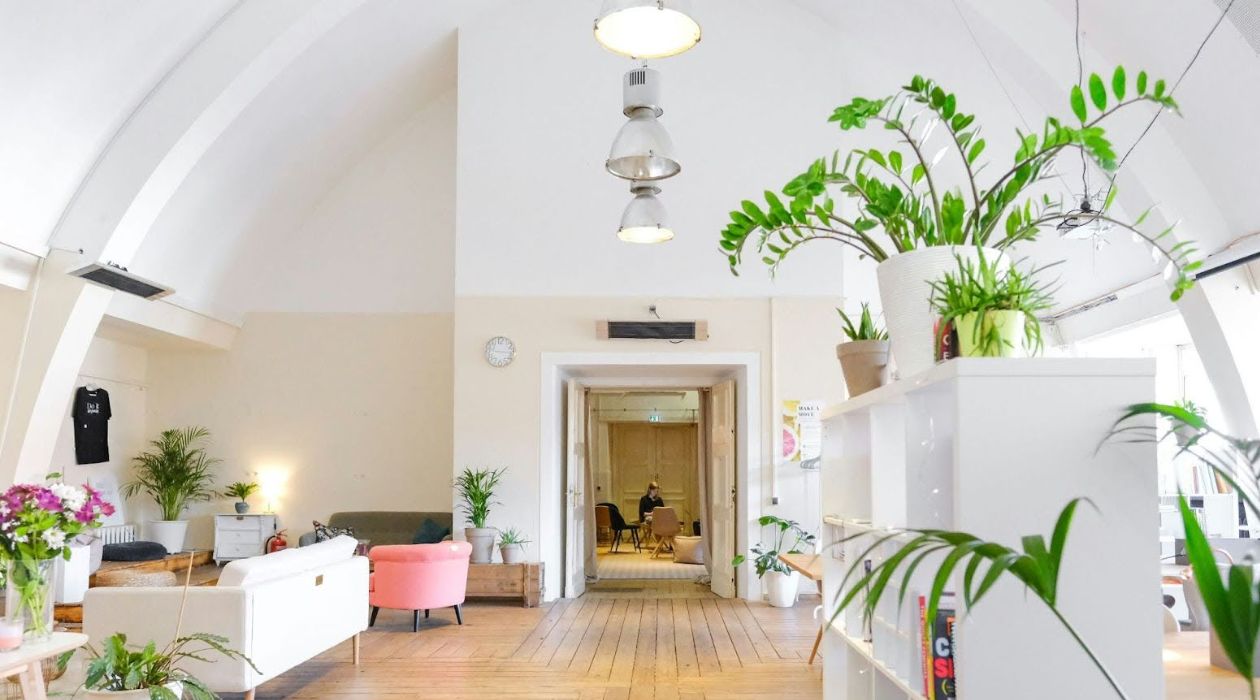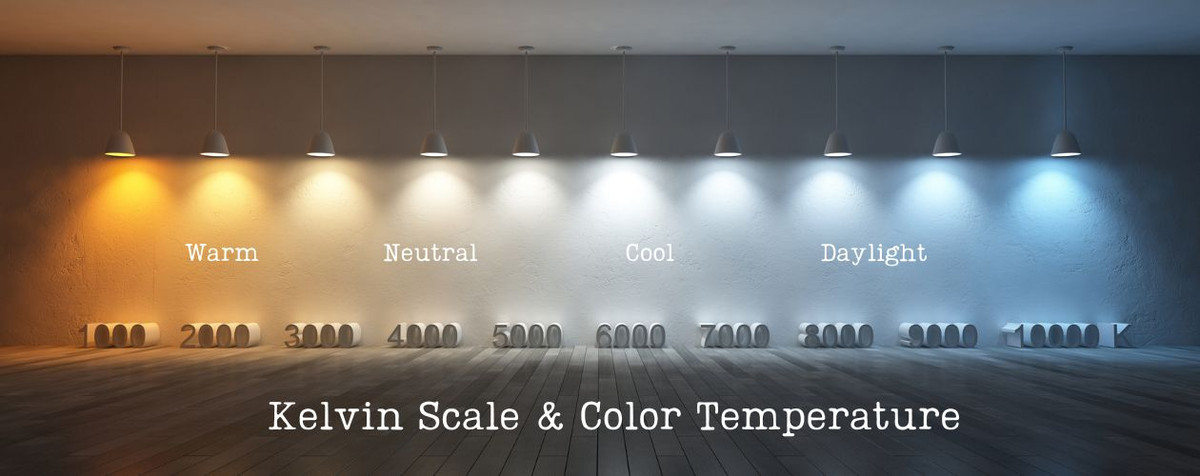101. The Kelvin Scale – Choosing The Right Color Temperature For Your LED Lighting
By Leah • May 30, 2024
Choosing the right color temperature for your LED lighting might sound like a daunting task, but once you understand the basics of the Kelvin scale, it’s a breeze! Whether you’re lighting up a cozy living room, an expansive office, or a bustling factory floor, the Kelvin scale will be your guiding star. Let’s dive into the fascinating world of LED light colors and discover how to create the perfect ambiance for any setting.
What is the Kelvin Scale?
The Kelvin scale is a measure of color temperature used to describe the appearance of light provided by a light source. Named after the physicist Lord Kelvin, the Kelvin light scale ranges from the warm, yellowish tones of low color temperatures to the cool, bluish hues of higher color temperatures. The scale ranges from 1,000 to 10,000 degrees Kelvin (or simply stated as K), with LED lighting typically falling in the 2,000K to 6,500K range. A light source's Kelvin rating is an expression of it's Correlated Color Temperature, also known as CCT. We might say a particular light fixture or bulb has a color temperature of 3500 Kelvin, representing the the color appearance given by the light.
How Does the Kelvin Scale Work?
Think of a blacksmith heating a metal rod. As the rod heats up, it changes color: glowing red at first, then turning yellow, white, and finally blue as it gets hotter. This progression mirrors the Kelvin light scale:
- Lower temperatures (2000K-3000K): Warm, yellowish light.
- Mid-range temperatures (3500K-4100K): Neutral white light.
- Higher temperatures (5000K-6500K): Cool, bluish light.
- Highest temperatures (8000K-10000K): Daylight

Choosing the Right LED Color Temperature
When selecting LED bulbs and lighting fixtures, it’s crucial to match the color temperature to the function and mood of the space. Let’s explore some common scenarios and the best Kelvin temperature for each.
Residential Spaces
For homes, you generally want warm colors to create an inviting atmosphere. Warm white light bulbs, with color temperatures ranging from 2700K to 3000K, are perfect for living rooms, dining areas, and bedrooms. These lower color temperatures create a soft, relaxing environment. Even lower color temperatures are sometimes preferred for nighttime environments and sleeping. We were recently mentioned in a Redfin article, check out the featured piece: Creating a Sleep Sanctuary | Rent.
Kitchen and Bathroom Lighting
Kitchens and bathrooms benefit from a slightly higher Kelvin color temperature. A neutral white light, around 3500K, provides a clearer, brighter light that helps with tasks like cooking and grooming without feeling too harsh.
Office and School Environments
In work and educational settings, lighting needs to be both functional and comfortable. Here, we typically deal in the range of 4000K. This neutral white light enhances concentration and reduces eye strain, making it ideal for desks and classrooms. Sometimes, you might see 3500K in these environments, which adds a touch of warmth while maintaining clarity.
Industrial and Manufacturing Areas
Industrial settings demand high visibility and alertness. A cool white light, around 5000K, is ideal for these areas. This bright, crisp light mimics daylight, ensuring tasks are performed safely and efficiently.
Sports Lights
Sports venues, whether indoors or outdoors, require powerful lighting to ensure visibility for both players and spectators. LED Lights for sports fields often use 5000K or even 5700K. This bright white light ensures every detail is visible, from the ball to the players' expressions.
Outdoor Lighting
Outdoor lighting fixtures need to balance visibility and ambiance. For pathways and general landscape lighting, 3500K to 4000K works beautifully, providing a warm, welcoming glow without being overpowering. Sometimes, for security or task-specific outdoor areas, 5000K can be used to offer a bright, clear light.
Color Rendering Index (CRI)
While the Kelvin scale is crucial for determining the right color temperature of your lighting, it’s also essential to consider the Color Rendering Index (CRI). CRI is a metric that measures the ability of a light source to reveal the true colors of objects accurately compared to natural light. It plays a vital role in how we perceive colors under different lighting conditions.
Understanding CRI
CRI is measured on a scale from 0 to 100, with 100 representing perfect color rendering, akin to natural daylight. A higher CRI indicates that the light source can display colors more accurately. For instance, a CRI of 80 or above is considered good, and a CRI of 90 or above is excellent.
Importance of High CRI
A high CRI is especially important in settings where color accuracy is critical:
- Art Studios and Galleries: Artists and curators need accurate color representation to ensure the true hues and tones of artwork are visible.
- Retail Stores: Proper lighting enhances the appearance of products, making them more appealing to customers.
- Photography and Film: Accurate color rendering is essential for capturing true-to-life images and footage.
- Healthcare: In medical environments, accurate color perception can be crucial for diagnosis and treatment.
Practical Tips for Selecting LED Lighting
When you’re on the hunt for the perfect indoor LED light fixture or outdoor wall pack, a little bit of foresight and planning can go a long way. Here are some practical tips to ensure you choose the ideal LED lighting for your space:
Determine the Purpose
Start by considering what the space will be used for. Different activities require different lighting conditions. For example:
- Task Lighting: For activities that require focus and precision, such as reading, sewing, or cooking, opt for higher color temperatures (4000K - 5000K). This cooler, brighter light enhances visibility and reduces eye strain, making it the perfect task lighting option.
- Ambient Lighting: For general room lighting, lower color temperatures (2700K - 3500K) are often preferred. These warmer tones create a cozy and inviting atmosphere perfect for living rooms and bedrooms.
Consider the Environment
The existing natural light in a room can significantly impact how artificial light is perceived. Rooms with abundant natural light can benefit from cooler LED temperatures to balance the warm sunlight and prevent the space from feeling overly yellow or dim. Conversely, in darker rooms or those with little natural light, warmer LED temperatures can create a more comfortable and natural ambiance.
Energy Efficiency
While all LED lights are energy-efficient compared to traditional incandescent bulbs, the color temperature can also influence energy use. Cooler temperatures (5000K and above) often appear brighter to the human eye, which means you can achieve the same level of illumination with fewer fixtures or lower wattage bulbs. This not only reduces your energy consumption but also your electricity bills.
Additional Tips
- Color Rendering Index (CRI): Pay attention to the CRI of the LED bulbs. A higher CRI (80 and above) ensures that colors appear more vibrant and true to life, which is particularly important in areas like kitchens, bathrooms, and art studios.
- Longevity and Durability: Check the rated lifespan of the LED bulbs. Higher quality LEDs might cost more upfront but save money in the long run due to their durability on longer lifespan.
- By keeping these tips in mind, you can make more informed decisions when selecting LED commercial lighting, ensuring that each space in your workplace is illuminated perfectly for its intended use.
Selecting the Best Commercial and Industrial Lighting For Your Space
Choosing the right color temperature for your LED lighting isn’t just about aesthetics—it’s about creating the right environment for your activities and needs. From the warm glow of a living room to the bright, clear light of a factory floor, understanding the Kelvin scale can help you make informed decisions that enhance both functionality and comfort.
Remember, with commercial and industrial lighting, we typically deal in the range of 4000K to 5000K. 5000K is excellent for industrial and manufacturing areas, while 4000K is great for office and school environments. Sports lights often use 5000K to 5700K, and outdoor lighting typically runs from 3500K to 5000K.
At OEO, we offer a wide selection of commercial and industrial lighting solutions tailored to meet your needs. From ceiling lights that brighten up your workspace to stadium lights that ensure excellent visibility for sporting events, our products cover every requirement. Explore our range of wall pack lights, LED strip lights, high bays, and more to find the perfect lighting for your project.
Ready to transform your space with the perfect lighting? Check out our selection at OEO or call our experts at (800) 553-2112 to see how the right light can make all the difference.
